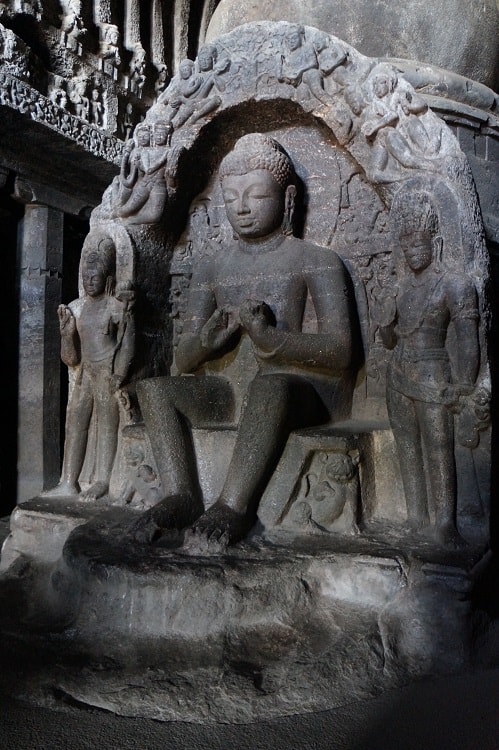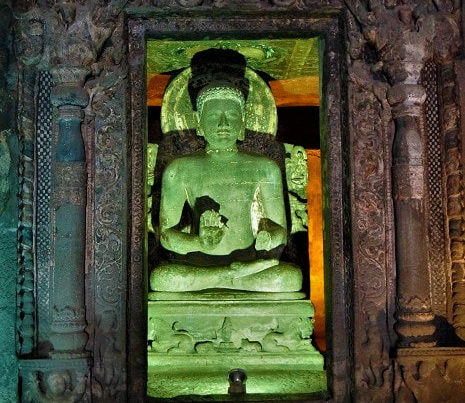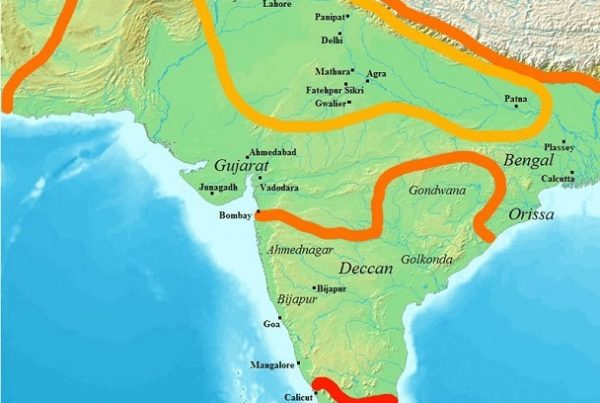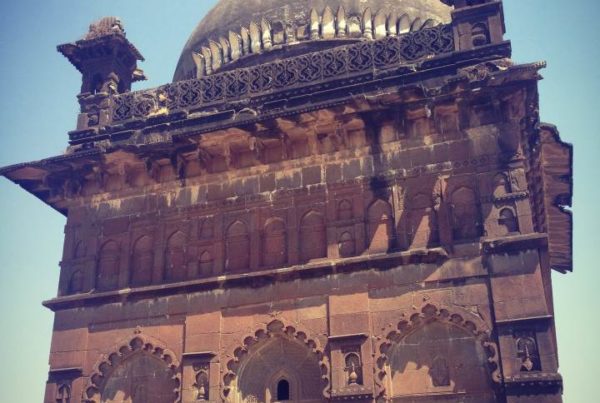Ellora Caves, one of India’s most significant historical landmarks, is a testimony to the country’s rich cultural heritage. Nestled in the Sahyadri Hills near Aurangabad, Maharashtra, these caves blend artistry, spirituality, and ancient engineering. In 1984, they have been declared a UNESCO World Heritage Site. Ellora Caves are a must-visit for history enthusiasts, art lovers, and spiritual seekers alike. In this article, we will delve into the historical and geographical significance of Ellora Caves and provide detailed travel information on how to reach this iconic site from major cities like Pune, Mumbai, and Delhi.
Historical Significance of Ellora Caves
The Ellora Caves date back to the 6th to 12th centuries CE and are a remarkable example of rock-cut architecture. The caves are divided into three distinct groups representing three major religions of ancient India: Hinduism, Buddhism, and Jainism. This religious diversity showcased in a single site highlights the spirit of tolerance and cultural coexistence that flourished in India during this period.
Hindu Caves (Caves 13–29)
The Hindu caves are among the oldest at Ellora, with the most significant being Cave 16, known as the Kailasa Temple. The Kailasa Temple is an architectural wonder carved entirely out of a single rock. It is dedicated to Lord Shiva and is designed to represent Mount Kailash, the mythical abode of the god. The sheer scale and intricate carvings of this monolithic structure are unparalleled, making it the centerpiece of Ellora.
Other notable Hindu caves include Caves 14 and 15, which depict various deities and scenes from Hindu mythology. The sculptures are detailed and vibrant, showcasing the skills of the artisans who worked on them over a millennium ago.
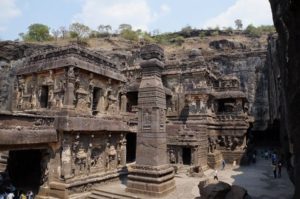
Kailash temple, cave n°16
Buddhist Caves (Caves 1–12)
The Buddhist caves at Ellora, dating from the 6th to 8th centuries, are among the earliest structures at the site. These caves were primarily used as monasteries, with Cave 10, also known as the ‘Vishvakarma Cave’ or the ‘Carpenter’s Cave,’ being the most prominent. It houses a large, seated Buddha in a preaching pose and is famous for its vaulted roof, which mimics the wooden beams of early Buddhist architecture.
The Buddhist caves reflect the simplicity and meditative ethos of Buddhism. They include prayer halls (viharas) and monasteries with intricate carvings that depict scenes from the life of Buddha, various bodhisattvas, and other symbolic motifs.
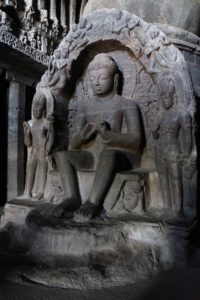
Buddhist caves, cave n°10
Jain Caves (Caves 30 –34)
The Jain caves at Ellora were created during the 9th and 10th centuries and are comparatively smaller but equally intricate. These caves are characterized by their elaborate detailing and the presence of statues of Tirthankaras (Jain spiritual teachers). Cave 32, also known as the Indra Sabha, is the most significant among the Jain caves. It features a beautifully sculpted lotus flower on the ceiling and a statue of Lord Mahavira seated on a lion throne.
The Jain caves reflect the austerity and spiritual focus of Jainism, with carvings that emphasize simplicity and divine grace. The peaceful ambiance of these caves provides a serene experience for visitors.
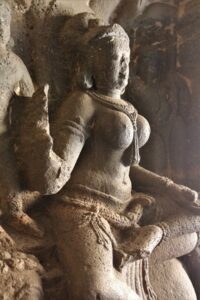
Jain caves
Religions present in the Ellora caves
For a comprehensive visit to the Ellora caves, you need to know about the three religions present there.
Buddhism
Buddhism, one of the world’s great religions and philosophies, originated in India over 2,500 years ago and spread throughout Asia and beyond. Founded on the teachings of the Buddha, it offers a spiritual path focused on liberation from suffering and the quest for enlightenment.
Origins of Buddhism
The life of Siddhartha Gautama
Buddhism has its roots in the life and teachings of Siddhartha Gautama, a prince born in the 6th century B.C. in Lumbini (in present-day Nepal).
Born into a royal Shakya family, he led a life of luxury, but was troubled by the sight of human suffering: old age, illness and death. Seeking a remedy for these universal realities, Siddhartha left his palace to live as an ascetic.
After years of meditation and severe asceticism, he realized that neither material pleasures nor extreme deprivation could lead to ultimate truth. Under a sacred fig tree in Bodh Gaya, he attained enlightenment, becoming the Buddha, “the Awakened One”.
The Buddha then spent the rest of his life teaching the Dharma, the path to liberation, and guiding his disciples to Nirvana, the state of extinction of desire and suffering.
Main concepts of Buddhism
The fundamental teachings of Buddhism are based on several key principles:
The Four Noble Truths
- Dukkha: Life is marked by suffering.
- Samudaya : The cause of suffering is desire (attachment).
- Nirodha: Suffering can be ended by attaining Nirvana.
- Magga : The path to end suffering is the Eightfold Path.
The Eightfold Path
This path offers a guide to living an ethical, meditative and enlightened life. It includes :
- Correct view (understanding truths)
- Correct intention
- Correct speech
- Correct action
- Correct living
- Correct effort
- Correct attention
- Correct concentration
The Law of Karma and Samsara
Karma refers to all actions (thoughts, words and deeds) that influence rebirths in the cycle of Samsara (the cycle of births and deaths). The aim of Buddhism is to free oneself from this cycle and attain Nirvana.
Anatta and Anicca
- Anatta (non-self): The idea that there is no permanent or unchanging self.
- Anicca (impermanence): The recognition that everything is in perpetual change.
The Three Jewels
Buddhists take refuge in :
- Buddha (the teacher)
- The Dharma (the teachings)
- The Sangha (the monastic or spiritual community).
Development and expansion
Buddhism in India
Buddhism spread rapidly thanks to the Buddha and his disciples. However, its growth was particularly marked during the reign of Emperor Ashoka (3rd century BC), who became a fervent Buddhist after the battle of Kalinga. He erected stupas, pillars and inscriptions to spread the Dharma throughout his empire and beyond.
The three main currents
Theravada (or Hinayana):
- Considered the oldest form of Buddhism, it focuses on the original teachings.
- Practiced in Southeast Asia (Sri Lanka, Thailand, Burma, Cambodia, Laos).
Mahayana:
- Developed in the 1st century BC, it emphasizes compassion and the role of the bodhisattva (enlightened beings helping others).
- Dominant in China, Japan, Korea and Vietnam.
Vajrayana:
- An esoteric form of Mahayana, incorporating tantric rituals.
- Practiced mainly in Tibet, Bhutan, Mongolia and parts of the Himalayas.
Expansion in Asia and worldwide
- Central Asia, China and Korea: Buddhism arrived thanks to merchants and missionaries along the Silk Road.
- In Japan: Introduced from Korea, it became a major cultural and spiritual force.
- In the West: Since the 19th century, Buddhism has inspired thinkers and spiritual seekers the world over.
The Sacred Places of Buddhism
Buddhism has 4 sacred sites. They are often linked to significant events in the Buddha’s life, or to important religious sites.
The Four Major Sites linked to the life of the Buddha
- Lumbini (Nepal): Birthplace of the Buddha.
- Bodh Gaya (India): Place of Buddha’s enlightenment under the Bodhi tree.
- Sarnath (India): Place of Buddha’s first sermon.
- Kushinagar (India): Place where the Buddha attained Parinirvana.
Other Important Sacred Places
- Rajgir: Where the Buddha taught many sutras and where the first Buddhist council was held.
- Nalanda: Renowned former Buddhist university.
- Ajanta and Ellora: Caves famous for their Buddhist frescoes and sculptures, representing Mahayana art.
- Borobudur (Indonesia): A giant mandala temple, symbol of the Buddhist universe.
- Temple of the Tooth (Sri Lanka): Place where a dental relic of the Buddha is kept.
- Potala Palace (Tibet): Former residence of the Dalai Lamas, symbol of Tibetan Buddhism.
Hinduism
Hinduism, often considered one of the world’s oldest religions, is a complex spiritual tradition that originated in India over 4,000 years ago. Rich in mythology, ritual practices and diverse philosophies, it is practiced today by over a billion people.
Origins of Hinduism
The roots of Hinduism
Hinduism has no single founder. Its origins date back to the Indus Valley civilization (circa 2600-1900 BC), combined with the beliefs and rituals of the Aryans who migrated to India around 1500 BC.
These Aryans introduced the Vedas, the Sanskrit sacred texts that form the basis of Hindu rituals and religious practices.
The evolution of the sacred texts
- The Vedas: Four main texts (Rigveda, Samaveda, Yajurveda, Atharvaveda) containing hymns, prayers and rituals.
- Upanishads (circa 800-200 BC): Philosophies and meditations on the nature of the universe, the self (Atman) and ultimate reality (Brahman).
- Epics: The Mahabharata (including the Bhagavad-Gita) and the Ramayana tell mythological stories rich in moral and spiritual teachings.
Main concepts of Hinduism
Brahman and Atman
- Brahman: The ultimate, infinite, universal reality.
- Atman: The individual soul or self, considered part of Brahman.
Dharma, Karma and Samsara
- Dharma: The duties, virtues and rules that guide each individual according to caste, age and role in society.
- Karma: An individual’s actions (thoughts, words and deeds) determine his future in this and subsequent lives.
- Samsara : The cycle of rebirth and death, influenced by karma.
Moksha
The ultimate goal of Hinduism is moksha, liberation from the cycle of samsara. This liberation enables the union of the Atman with Brahman.
Trimurti: The Three Principal Divinities
- Brahma: Creator of the universe.
- Vishnu: The protector and preserver of the universe.
- Shiva: The destroyer, symbol of transformation and renewal.
Gods and goddesses
Hinduism recognizes millions of deities, each representing specific aspects of life or the universe. Among the most venerated are:
- Lakshmi (goddess of wealth)
- Saraswati (goddess of knowledge)
- Parvati (mother goddess, wife of Shiva)
- Ganesh (elephant-headed god, symbol of prosperity and success).
The Four Ways to Salvation
Hinduism offers several paths to spiritual liberation:
- Bhakti Yoga: Devotion to a deity.
- Karma Yoga: The path of selfless action.
- Jnana Yoga: Path of knowledge.
- Raja Yoga: Path of meditation and mental discipline.
Development and Expansion of Hinduism
Vedic period (1500-500 BC)
Hinduism developed around Vedic rituals, involving fire worship and animal sacrifice. These practices were carried out by a caste of priests, the Brahmins.
Period of the Upanishads (800-200 BC)
This period marks a transition to a more philosophical approach. Questions about the nature of the soul, the universe and the divine became central.
Classical period (200 BC – 500 AD)
With the writing of the great epics (Mahabharata and Ramayana), Hinduism is enriched by narratives that capture moral and spiritual ideals. The worship of deities such as Vishnu and Shiva became predominant.
World expansion
Thanks to merchants and scholars, Hinduism spread throughout Southeast Asia, profoundly influencing the cultures of countries such as Indonesia, Malaysia, Thailand and Cambodia. In these countries, many examples of this influence remain, such as Angkor Wat.
The Sacred Places of Hinduism
For Hindus, pilgrimages play a central role in their spirituality. Sacred places are often associated with rivers, mountains or mythological events.
The Seven Sacred Cities (Sapta Puri)
- Varanasi (Kashi): Located on the banks of the Ganges, this is one of the world’s oldest cities. Considered the spiritual capital of India, it is a place of cremation and purification.
- Ayodhya: Birthplace of the god Rama.
- Mathura: Birthplace of Krishna.
- Haridwar: Gateway to the Ganges, where pilgrims come to purify themselves in its sacred waters.
- Kanchipuram: City of temples, dedicated to Shiva and Vishnu.
- Ujjain: Place associated with the Mahakaleshwar, one of the twelve jyotirlingas (sacred representations of Shiva).
- Dwarka: Mythical city of Krishna, located in Gujarat.
Other sacred sites
There are many places of importance to Hinduism. Nashik, for example, is the setting for part of the Ramayana. The city boasts numerous temples along the Godavari River. Every 12 years, it also hosts the Kumbh Mela, the world’s largest religious pilgrimage.
Sacred rivers
- The Ganges: Symbolizes purity and freedom from sin.
- The Yamuna, Saraswati and Godavari: Also venerated for their purifying powers.
Majestic temples
- Brihadeeswara Temple (Tamil Nadu): A masterpiece of Chola architecture dedicated to Shiva.
- Jagannath temple (Odisha): Famous for the Ratha Yatra festival.
- Meenakshi temple (Madurai): Dedicated to Parvati and Shiva, famous for its sculptures.
- Kailash Temple (Maharashtra): The world’s largest monolithic monument, dedicated to Shiva.
- Angkor Wat (Cambodia): Although a Khmer site, this temple is dedicated to Vishnu and bears witness to the influence of Hinduism in Asia.
Sacred mountains and hills
- Mount Kailash (Tibet): regarded as the abode of Shiva.
- Mount Arunachala (Tamil Nadu): Place of veneration of Shiva in his fire form.
Jainism
One of India’s oldest spiritual traditions, Jainism is a philosophy based on absolute non-violence (ahimsa), the search for truth and asceticism. It is distinct from other Indian religions such as Hinduism and Buddhism, although it shares certain philosophical ideas with them.
Origins of Jainism
The roots of Jainism
Jainism has its origins in ancient India, at a time when spiritual and philosophical questioning was flourishing. Its teachings are rooted in a pre-Vedic tradition, long before the Vedas, but it is often associated with the figure of Mahavira, considered the 24th Tirthankara (spiritual master or “ford-maker”).
Mahavira (599-527 BC)
Mahavira, also known as Vardhamana, was the reformer of Jainism. Born into a royal family in present-day Bihar, he renounced his material comforts at the age of 30 to lead a life of strict asceticism. After 12 years of meditation and privation, he attained enlightenment and became a Jina (“victorious”), having conquered the passions and attachments of the material world.
Mahavira’s teachings focus on the purification of the soul and the attainment of liberation (moksha), marking a continuity with the ideas transmitted by previous Tirthankaras.
Main concepts of Jainism
Non-violence (Ahimsa)
Jainism is founded on ahimsa, or absolute non-violence. This includes not only the prohibition of harming any living being, but also of causing unintentional harm, whether to humans, animals or even microscopic life forms.
The Three Jewels (Ratnatraya)
- Correct faith (Samyak Darshana): Understanding of the true nature of the universe and trust in the teachings of the Tirthankaras.
- Correct knowledge (Samyak Jnana): Knowledge of the fundamental principles of reality.
- Correct conduct (Samyak Charitra): Following ethical discipline to purify the soul.
The Five Ethical Vows
- Ahimsa: Non-violence.
- Satya: Truth.
- Asteya: Non-stealing.
- Brahmacharya: Chastity.
- Aparigraha: Non-possession or detachment from material possessions.
Karma and Liberation
In Jainism, karma is a subtle substance that attaches itself to the soul through actions and passions. The aim is to purify the soul of all karma in order to attain liberation (moksha), a state of pure, eternal existence.
The two main communities
- Shvetambaras: monks and nuns dressed in white, advocating a less strict ascetic lifestyle.
- Digambaras: monks practicing total renunciation, including of clothing, symbolizing absolute detachment.
Development and expansion of Jainism
Emergence and rise
Jainism developed in parallel with Buddhism in ancient India. While Buddhism spread abroad, Jainism remained mainly centered in India, retaining a strong community in the western and southern regions of India.
Decline and revival
Over time, Jainism lost its political influence, particularly after the rise of Hinduism and Islam. However, Jain communities continued to thrive as merchant groups and artistic patrons. Today, Jainism remains alive, albeit in a minority, and is recognized for its philosophical and ethical contributions.
The Sacred Places of Jainism
Pilgrimage is an essential part of Jain spiritual life. Sacred places are often located on mountains or in magnificently adorned temples.
Sacred mountains
- Shatrunjaya (Palitana, Gujarat): A hill famous for its hundreds of Jain temples, built in white marble.
- Parasnath Hill (Jharkhand): Associated with the 23rd Tirthankara, Parsvanatha.
- Girnar (Gujarat): A sacred site for the two main sects, Shvetambaras and Digambaras.
- Mangi Tungi (Maharashtra): This site boasts the world’s largest Jain statue.
Magnificent temples
- Dilwara temples (Rajasthan): Renowned for their marble sculptures, these temples on Mount Abu are an architectural masterpiece.
- Ranakpur Temple (Rajasthan): Dedicated to Adinatha, the first Tirthankara, this temple is famous for its 1444 finely sculpted columns.
- Shravanabelagola (Karnataka): Home to a giant statue of Gomateshwara (Bahubali), this site is a major symbol of non-violence and renunciation.
Other important sites
- Lumbini (Nepal): Considered the birthplace of several Tirthankaras, as well as being associated with Buddhism.
- Pavapuri (Bihar): Place where Mahavira attained nirvana.
Geographical Information and Layout
Ellora Caves are situated in the Deccan plateau region of India, specifically in the Sahyadri Hills near Aurangabad, Maharashtra. The site extends over a 4-kilometer area and consists of 34 caves carved into the basalt rock cliffs. The caves are aligned from north to south, with the Buddhist caves located in the southern part, the Hindu caves in the central section, and the Jain caves in the northern part.
Climate and Best Time to Visit
Ellora experiences a typical tropical climate, with hot summers, a moderate monsoon season, and pleasant winters. The best time to visit Ellora Caves is between November and March when the weather is cooler and more comfortable for exploration. During the monsoon season (June to September), the surrounding landscape becomes lush and green, providing a beautiful backdrop for the caves, though some areas may be slippery.
Layout and Accessibility
The caves are numbered from south to north, with Cave 1 being the southernmost and Cave 34 being the northernmost. The Kailasa Temple (Cave 16) is centrally located and easily accessible, serving as a focal point for visitors. Most caves have well-maintained pathways, and the site is relatively easy to navigate, though some parts may require a bit of climbing, particularly in the Jain section.
How to Reach Ellora Caves
Ellora Caves are well-connected by road, rail, and air, making them accessible from major cities like Pune, Mumbai, and Delhi. We can organise all your journey from any city. Here’s how you can reach Ellora Caves from these cities:
From Pune to Ellora Caves
By Flight:
The nearest airport to Ellora Caves is Aurangabad Airport, which is approximately 30 kilometers from the site. There are direct flights from Pune to Aurangabad, which take around an hour. From the airport, you can hire a taxi or take a bus to reach Ellora Caves.
By Bus:
Several state-run and private buses operate between Pune and Aurangabad. The journey by bus takes approximately 5 to 6 hours. From Aurangabad bus station, local buses and taxis are available to reach Ellora Caves.
By Car:
If you prefer driving, the distance between Pune and Ellora Caves is about 256 kilometers. The drive takes around 5 to 6 hours via the Pune-Nashik Highway and Aurangabad Road. The road conditions are generally good, and the route passes through scenic landscapes, making it a pleasant drive.
From Mumbai to Ellora caves
By Flight:
Mumbai is well-connected to Aurangabad by direct flights, with a flight duration of around 1.5 hours. Upon arrival at Aurangabad Airport, taxis and buses are available to take you to Ellora Caves.
By Bus:
Several state-run and private buses connect Mumbai to Aurangabad. The bus journey takes about 7 to 8 hours. From Aurangabad, local transportation options are available to reach the caves.
By Car:
The distance from Mumbai to Ellora Caves is approximately 340 kilometers, and the drive takes around 7 to 8 hours. The route via the Mumbai-Nashik Highway and Aurangabad Road offers a scenic and comfortable drive. It is advisable to start early in the morning to avoid traffic and reach Ellora by noon.
From Delhi to Ellora caves
By Flight:
The most convenient way to reach Ellora Caves from Delhi is by flight. Direct flights from Delhi to Aurangabad take about 2 hours. After landing at Aurangabad Airport, you can take a taxi or bus to reach the caves.
By Train:
There are several trains that run from Delhi to Aurangabad, including the Nizamuddin Express and Hazur Sahib Nanded Express. The train journey takes approximately 18 to 20 hours. Upon reaching Aurangabad Railway Station, taxis and buses are available for the 30-kilometer journey to Ellora Caves.
By Car:
Driving from Delhi to Ellora Caves is a long journey, covering about 1,400 kilometers. The drive would take around 24 to 26 hours, depending on the route and traffic conditions. Given the distance, it’s recommended to break the journey into segments and rest along the way. The route via NH44 and NH52 is commonly taken by those driving from Delhi to Maharashtra.
Other Must-Visit Places Near Ellora Caves
When planning your visit to Ellora Caves, don’t miss the opportunity to explore several nearby attractions that offer a deeper dive into the region’s rich history and culture. Here are some must-visit places near Ellora Caves:
1. Daulatabad Fort
Just 16 kilometers from Ellora Caves, Daulatabad Fort (also known as Devagiri) is one of the most formidable forts in India. Renowned for its robust defense mechanisms, including a crocodile-filled moat and a maze-like entrance, this 12th-century fort is a masterpiece of military architecture. Visitors can explore its impressive fortifications and enjoy panoramic views of the surrounding landscape, making it a must-see destination for history enthusiasts and architecture lovers alike.
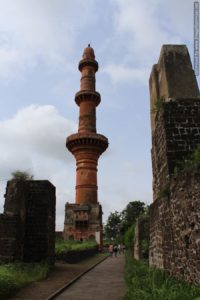
Daultabad fort
2. Grishneshwar Temple (Jyotirlinga Temple)
Located just a few minutes away from Ellora Caves, Grishneshwar Temple is one of the 12 sacred Jyotirlingas dedicated to Lord Shiva. This ancient temple is a significant pilgrimage site, attracting devotees from across the country. The temple’s intricate carvings and serene ambiance make it a spiritual haven, and its proximity to Ellora Caves makes it a convenient and essential stop for visitors. Including Grishneshwar Temple in your itinerary will enhance your cultural and spiritual experience of the region.
3. Khuldabad Village
Khuldabad Village, situated only 4 kilometers from Ellora Caves, is steeped in historical and spiritual significance. Known as the “Valley of Saints,” Khuldabad is home to the tomb of Mughal Emperor Aurangzeb, a site that contrasts sharply with the grandiosity of other Mughal monuments. The village is also dotted with the dargahs of revered Sufi saints, offering a peaceful and reflective experience. A visit to Khuldabad Village provides insight into the spiritual heritage of the region and the austere life of one of India’s most powerful rulers.
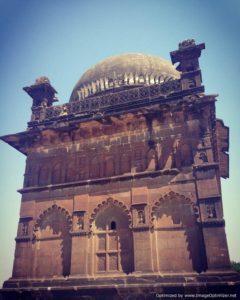
Malik Ambar tonb in Khuldabad
4. Bibi Ka Maqbara
Located approximately 30 kilometers from Ellora Caves in Aurangabad, Bibi Ka Maqbara is often called the “Taj of the Deccan.” This stunning mausoleum, built by Emperor Aurangzeb in memory of his wife Dilras Banu Begum, is a fine example of Mughal architecture. The monument, set amidst well-manicured gardens, offers a tranquil environment and is a popular attraction for those who appreciate history and architecture. A visit to Bibi Ka Maqbara adds a touch of Mughal grandeur to your trip, rounding out your exploration of Aurangabad’s historical sites.
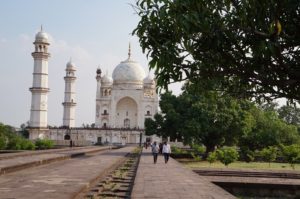
Bibi ka Maqbara
Don’t forget these places
Ellora Caves are surrounded by a wealth of historical and cultural attractions that should not be missed. Daulatabad Fort, Grishneshwar Temple, Khuldabad Village, and Bibi Ka Maqbara are all nearby and offer unique experiences that complement your visit to Ellora. By including these sites in your itinerary, you’ll gain a comprehensive understanding of the rich heritage of the Aurangabad region, making your trip truly unforgettable.
Plan Your Visit with Akvin Tourism:
For a seamless and memorable visit to Ellora Caves and the nearby attractions, choosing the right travel partner is crucial. Akvin Tourism, recognized as the best travel agency in Aurangabad (Chhatrapati Sambhajinagar), offers exceptional services that ensure a hassle-free and enriching experience. Known for their friendly and familiar trip experiences, Akvin Tourism specializes in customized tours that allow you to explore Ellora Caves, Daulatabad Fort, Grishneshwar Temple, Khuldabad Village, and Bibi Ka Maqbara with ease and comfort.
Whether you’re planning a spiritual journey to the sacred Grishneshwar Temple, an exploration of the historical Daulatabad Fort, or a cultural visit to the iconic Bibi Ka Maqbara, Akvin Tourism provides expertly guided tours that highlight the best of Aurangabad (Chhatrapati Sambhajinagar). With their deep local knowledge, excellent customer service, and commitment to creating memorable experiences, Akvin Tourism stands out as the top choice for travelers visiting the region.
By booking your tour with Akvin Tourism, you can be assured of a well-organized, enjoyable trip that covers all the must-see sites near Ellora Caves. Their expertise and dedication make them the go-to travel agency for anyone looking to explore the rich history and culture of Aurangabad (Chhatrapati Sambhajinagar).

